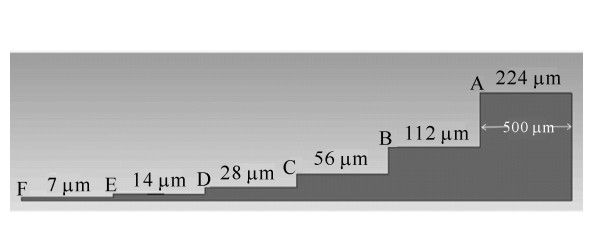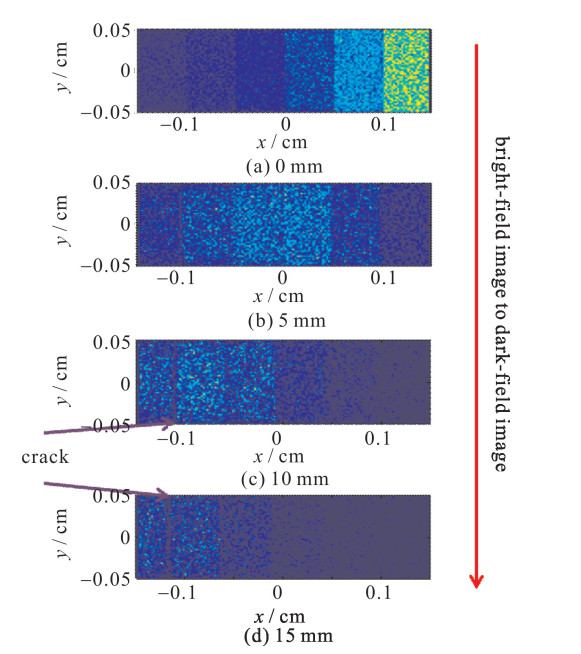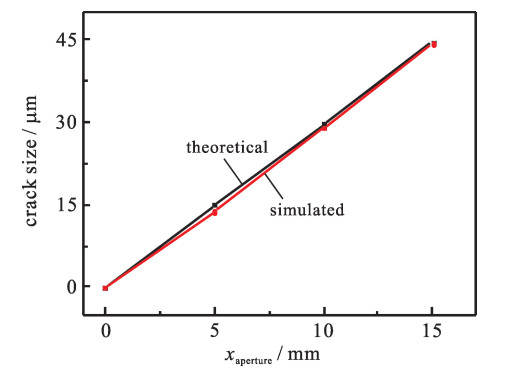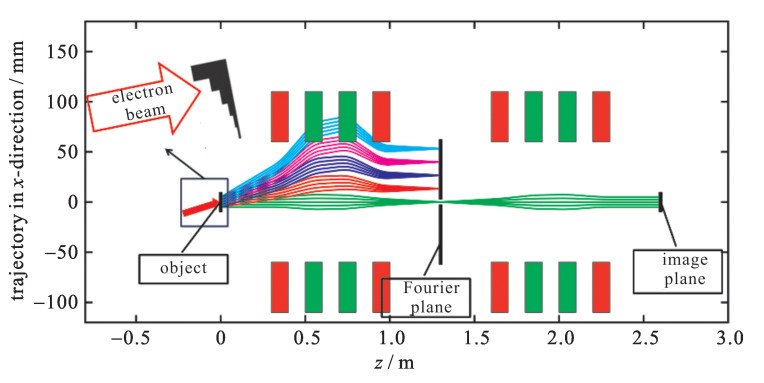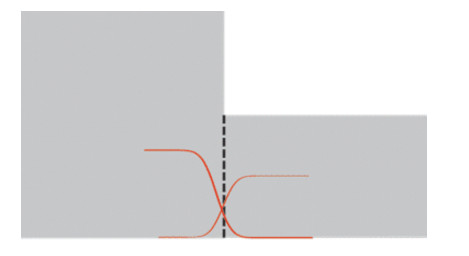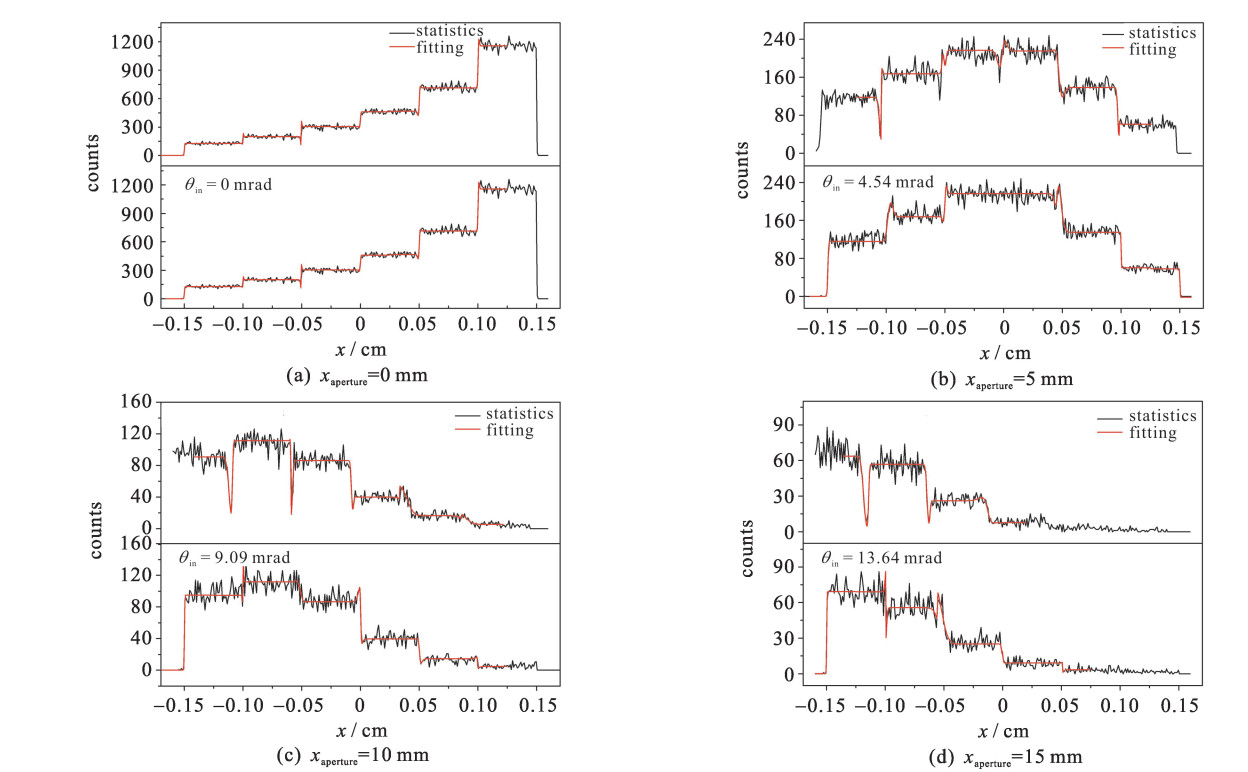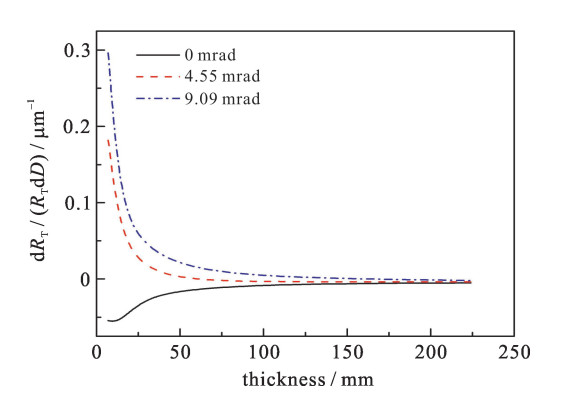Characteristics and improvement scheme of dark-field imaging of high energy electron radiography
-
摘要: 基于EGS5与PARMELA模拟软件组成的高能电子成像系统,对暗场成像的模拟研究发现,通过调节光阑位置实现的暗场成像结果存在失真现象。针对该失真现象提出的改进方案,消除了暗场成像结果的失真。通过对40 MeV电子透射7~224 μm的铝样品开展的成像模拟结果表明:40 MeV高能电子暗场成像技术在铝样品厚度小于25 μm情况下具有明显的面密度分辨优势,且空间分辨率达到μm量级,非常适用于高能量密度物质诊断。Abstract: The simulations of dark-field imaging of high energy electron radiography show that the dark field imaging is distorted in the case of large angle selected. In order to eliminate distortion, an optimized scheme is proposed in this paper. The results of high Energy Electron Radiography (HEER) simulations by optimization show that the dark-field image has better areal density resolution when the thickness of aluminum target is less than 25 μm, and the spatial resolution of dark-field imaging is about several microns. In summary, dark-field imaging of high energy electron radiography is ideal to thin warm dense matter specimen diagnosis.
-
光波在大气中传输时会受到大气湍流的影响,大气湍流的扰动频率通常可以达到上百赫兹。并且,湍流大气中光波传输的理论研究与技术应用都涉及光波或波前时间频谱的高频特征[1]。通常通过测量大气温度场的起伏获取大气光学湍流谱,而高空间波数、位于耗散区的湍流谱不易获得。温度脉动仪是一种测量大气湍流特性的常用仪器,其工作原理为:通过测量温度脉动,可以得到温度起伏谱和湍流的折射率结构常数。常用温度脉动仪一般选取的感应材料为铂丝,它具有响应快速、线性度好、体积小等优点[2]。一般选取直径20 μm或者10 μm的铂丝作为感应材料[3],然而,由于铂丝的响应频率等方面的限制,常规温度脉动仪只能获取20 Hz以下频率的温度脉动信号,无法研究大气一维温度谱的高频特征;美国空军实验室使用两款探空温度脉动仪开展了高空大气湍流强度廓线对比测量实验[4],根据文献提供的参数计算分析,仪器具有较高的响应频率,但是其探头电流增温效应较大,对测量结果的准确性产生一定影响[5]。钨丝具有类似铂丝的线性温度特性,且韧性好、性价比高、温度系数较大,本文提出了一种温度脉动仪的改进设计方案,采用直径6 μm、电阻值20 Ω的钨丝作为感应材料,它在环境温度293 K、风速2 m/s的条件下,响应频率可以达到133 Hz;流过钨丝的电流只有0.5 mA,电流增温对结果影响小;它具有探头体积小、分辨率高、噪声低和受环境影响小等特点。利用改进后的温度脉动仪对实际大气温度起伏进行了观测实验,得到了更宽频率范围的温度起伏信号,获得了不同湍流强度下的温度起伏功率谱,并对其谱幂率进行了统计分析。
1. 温度脉动仪改进设计
在满足局地均匀各向同性的条件下, 根据Kolmogorov理论[6], 大气中两点间温度的空间结构函数为
(1) 式中:空间结构函数用空间两点温差的时间统计平均表示; CT2是温度结构常数。
大气湍流强度一般用折射率结构常数Cn2表征,Cn2与CT2的关系为
(2) 式中: p是压强,单位hPa; T是热力学温度,单位K。通过测量空间中两点的温度脉动,并结合式(1)~(2),可以计算出湍流的空间结构参数。
改进之前的温度脉动仪电路使用单个集成运放实现加减运算功能,它存在两个缺点,一是电阻的选取和调整不方便,二是对于每个信号源的输入电阻均较小[7],影响信号传输的准确性。综合考虑带宽和降噪的要求,本设计采用非平衡电桥和两级差分放大电路对信号进行采集和放大,它具有信号输入电阻大、电阻选取方便和高共模抑制比(CMRR)等特点[8],可降低电路噪声,减少电子元器件对信号的影响,保证信号的准确性。图 1是改进前后的信号采集电路,图中R3和R4是感应金属丝,V0是经过恒压处理后的电压源。
传感器的响应频率和风速、传感器的形状以及材料有关,金属丝可看成直径为d,长度一定的圆柱形。表 1给出了在风速2 m/s的条件下,直径6 μm的钨丝的时间常数和响应频率等参数,计算用变量包括:风速u, 钨丝直径d, 粘滞系数υ, 干空气导热系数λg, 钨丝密度ρ, 钨丝比热容c。
表 1 钨丝参数(293 K, 2 m/s,105 Pa)Table 1. Parameters of tungsten wire(293 K, 2 m/s, 105 Pa)Re Nu h/(W·m-2·K-1) M/ms fs/Hz R/Ω ρ0/(Ω·mm2·m-1) d/μm 0.797 0.732 3 159.8 1.194 133.29 20 0.055 6 温度脉动信号属于交流信号,所以需要滤除信号中的直流成分,为降低高频噪声对信号的影响,结合表 1给出的直径6 μm的钨丝响应频率为133 Hz,经过计算分析,设计出通带频率范围为0.084~186 Hz的有源带通滤波器,对信号进行滤波处理。
为验证仪器测量信号的准确性,将振幅为100 mV、频率为60 Hz的源信号衰减104倍,模拟微弱信号,输入到采集电路中,将输出信号与源信号进行对比,如图 2所示,结果表明,经过采集系统的信号没有失真,只有一定时延,对信号采集没有影响。将整个仪器放置在恒温、恒压环境中进行仪器本底噪声测量实验,输出结果按照电压和温度转换关系转化为温度值,测得整个仪器本底噪声等效的温度脉动在0.001 7 K范围内,结果如图 3所示。
综上,改进后的温度脉动仪满足测量大气温度起伏的需求。
2. 温度起伏功率谱
在局部均匀各向同性假定的条件下,例如大气温度起伏的一维谱满足-5/3定律[9-10],即
(3) 式中: CT2表示温度结构常数;波数k=2π/l,其中l为温度起伏的空间尺度;L0为湍流的外尺度;l0为湍流的内尺度。式(3)表示的就是所谓的Kolmogorov湍流谱,是波在随机介质中传播理论的一个基础[11]。
根据泰勒假定,频率和波数之间有如下关系
式中: f为频率;v表示风速。只要分析频率谱就能确定温度脉动功率谱是否和Kolmogorov的-5/3定律一致[3]。
使用传统温度脉动仪测量温度脉动,其温度谱反映的仅是整个谱区间的一部分,大部分针对温度起伏谱特征的研究主要集中在低频部分,而对于更高频率范围内温度起伏谱特征的研究很少。根据上一节的描述,本次实验使用的温度脉动仪测量频率上限可以达到190 Hz,涵盖了大部分大气温度起伏范围,有助于研究温度起伏谱高频部分的幂率特征。
2018年10月2日至10月6日开展了实际大气温度谱的测量实验,取得大约6700个温度起伏谱。图 4分别是弱湍流、中等湍流和强湍流时的温度起伏谱,分析温度谱发现:温度谱的形状和湍流强度有一定关系,具体表现在,弱湍流时,温度谱的频谱范围小,相较于-5/3谱偏平,随着湍流增强,频率范围变大,温度谱变陡,但幂率不会小于-3。这与文献[12]的结论类似。相较于之前的研究,本次实验探测到的温度起伏谱频率范围更宽,而且依然具有幂率不变的特性。
为研究温度谱幂率的统计特征,对所有温度起伏谱进行线性拟合,并进行幂率统计。考虑到有限的采样时间所造成的谱型有细小差别以及线性拟合存在误差等不确定因素[3],我们把幂率为-5/3±0.2的谱都认为符合-5/3定律。为便于统计,将所有温度起伏谱在0.1~35 Hz频率范围内线性拟合。统计结果如表 2所示,图 5是温度谱幂率的分布情况。从统计结果可以看出,在0.1~35 Hz频率范围内有52%的温度谱幂率在-5/3±0.2范围内,但是,仍有很多情况不符合Kolmogorov理论,幂率偏离了理论值,表明实际大气中有大量非K湍流存在,这与文献[3, 12-13]的结果一致。
表 2 6 μm直径的钨丝不同幂率温度谱出现的概率Table 2. Probability distributions of power law measurement with 6 μm tungsten wirepower law k probability/% >-5/3+0.20 1.6 -5/3-0.20~-5/3+0.20 52.2 -5/3-0.20 46.2 在本次实验期间获得的温度起伏谱中,有许多温度谱在高频部分出现拐点, 以更陡的斜率下降,图 6显示了在不同时刻具有拐点的温度起伏谱。分析发现,在拐点之前,温度起伏谱的幂率在-5/3附近,而拐点之后的幂率严重偏离了-5/3。对比图 6(a),(b),拐点出现的位置和湍流强度有一定的关系。但是,湍流强度并不是拐点向高频方向移动的充分条件,可能和风速、大气层结稳定度等因素有关。实际大气中风速均匀性的假设、冻结湍流假设不能很好地符合,因此频谱的实际分布要比理论预期的复杂[14]。有资料表明,即使充分发展的湍流,温度场的统计特征对大尺度能量的注入、温度梯度和温度速度相关性也特别敏感[15],其表现之一就是随着气候和其他条件的不同,湍流能量谱分布有所变化[13]。
3. 结论
使用宽频带的温度脉动仪对真实大气温度起伏进行了观测实验,结果表明:改进后的温度脉动仪可以探测到更高频率的温度起伏信号,发现湍流具有丰富的高频信息,在高频区间依旧存在幂率不变的特性, 且温度起伏功率谱的形状和湍流强度有一定关系。部分温度起伏功率谱在高频部分出现拐点,而且出现的位置和湍流强度有一定关系,但是拐点出现的原因、影响其位置的因素较为复杂。实际大气中有大量的非Kolmogorov湍流存在,研究非K大气湍流本身特性,对湍流理论、非K大气湍流中光传播效应的数值模拟、非K大气湍流对各种光电工程的影响等方面的研究具有重要意义[16],本文成果可以为建立用于光传播数值模拟的非K湍流模型提供有力支持,并为数值模拟结果的验证工作提供实际测量数据。大气温度起伏谱的高频特性、影响温度谱幂率的因素、温度谱幂率的空间分布特征等问题,还需要进一步的研究。
致谢: 感谢曾宗泳老师在电路设计方面的指导,感谢吴晓庆老师在温度谱分析方面的建议。 -
表 1 靶平面至Fourier面处的传输矩阵参数
Table 1. Matrix parameters of transport from object plane to Fourier plane
R11F R12F/(mm·mrad-1) R33F R34F/(mm·mrad-1) -3.0×10-3 1.1 -6.7×10-3 -5.3 表 2 成像系统传输矩阵参数
Table 2. Matrix parameters of transport from object plane to image plane
R11 R12/(mm·mrad-1) R21/(mm·mrad-1) R22 R33 R34/(mm·mrad-1) R43/(mm·mrad-1) R44 -1.0 -6.67×10-3 4.8×10-3 -1.0 -1.0 -7.10×10-3 2.35×10-2 -1.0 表 3 不同光阑位置对应的角度筛选区间
Table 3. Angle range selected for different aperture position setting
xaperture/mm angle selected/mrad xaperture/mm angle selected/mrad 0 -0.23~0.23 10 8.86~9.32 5 4.32~4.78 15 13.40~13.87 表 4 不同入射角度情况下,对于不同厚度铝样品的空间分辨
Table 4. Spatial resolution for different steps and different incident angle
incident angle/mrad RMS spatial resolution for different steps/μm 7 μm 14 μm 28 μm 56 μm 112 μm 224 μm 0 5 6 5 4 2 3 4.54 3 2 10 9 14 5 9.09 3 1 7 5 2 3 13.64 1 5 2 10 3 -
[1] Council N, Ebrary I. Frontiers in high energy density physics: the X-games of contemporary science[M]. National Academies Press, 2003. [2] Zhao Yongtao, Zhang Zimin, Gai Wei, et al. High energy electron radiography scheme with high spatial and temporal resolution in three dimension based on a e-LINAC[J]. Laser and Particle Beams, 2016, 34(2): 338-342. doi: 10.1017/S0263034616000124 [3] Merrill F, Harmon F, Hunt A, et al. Electron radiography[J]. Nuclear Instruments and Methods in Physics Research Section B: Beam Interactions with Materials and Atoms, 2007, 261(1/2): 382-386. [4] Merrill F E, Goett J, Gibbs J W, et al. Demonstration of transmission high energy electron microscopy[J]. Applied Physics Letters, 2018, 112: 144103. doi: 10.1063/1.5011198 [5] Zhao Quantang, Cao Shuchun, Shen Xiaokang, et al. Design and simulation study of ultra-fast beam bunches split for three orthogonal planes high-energy electron dynamic radiography[J]. Laser and Particle Beams, 2017, 35(4): 579-586. doi: 10.1017/S0263034617000647 [6] Zhao Quantang, Cao Shuchun, Liu Ming, et al. Beam optical design for high energy electron radiography experiment study based on THU LINAC[J]. Physics, 2015. [7] Zhou Zheng, Du Yingchao, Cao Shuchun, et al. Experiments on bright-field and dark-field high-energy electron imaging with thick target material[J]. Physical Review Accelerators and Beams, 2018, 21: 074701. doi: 10.1103/PhysRevAccelBeams.21.074701 [8] 卢亚鑫, 杨国君, 魏涛, 等. 高能电子照相成像模糊模拟研究[J]. 强激光与粒子束, 2016, 28: 014002. doi: 10.11884/HPLPB201628.014002Lu Yaxin, Yang Guojun, Wei Tao, et al. Image blur in high energy electron radiography. High Power Laser and Particle Beams, 2016, 28: 014002 doi: 10.11884/HPLPB201628.014002 [9] Wei Tao, Li Yiding, Yang Guojun, et al. An accelerator scenario for a hard X-ray free electron laser combined with high energy electron radiography[J]. Chinese Physics C, 2016, 40: 088101. doi: 10.1088/1674-1137/40/8/088101 [10] 王致远, 杜应超, 黄文会. 基于蒙卡和粒子示踪程序的电子成像模拟分析[J]. 强激光与粒子束, 2014, 26: 114007. doi: 10.11884/HPLPB201426.114007Wang Zhiyuan, Du Yingchao, Huang Wenhui. Simulation analysis of electron imaging method based on Monte Carlo simulation and particle tracer software. High Power Laser and Particle Beams, 2014, 26: 114007 doi: 10.11884/HPLPB201426.114007 [11] Xiao Jiahao, Zhang Zimin, Cao Shuchun, et al. Areal density and spatial resolution of high energy electron radiography[J]. Chinese Physics B, 2018, 27: 035202. doi: 10.1088/1674-1056/27/3/035202 [12] Jiang Xiaoguo, Wang Yuan, Yang Zhiyong, et al. Time-resolved measurement technique for pulsed electron beam envelope basing on framing and streaking principle[J]. Chinese Physics C, 2016, 40: 017003. doi: 10.1088/1674-1137/40/1/017003 [13] 江孝国, 王远, 代志勇, 等. 高速分幅相机在强流脉冲电子束调试中的应用研究[J]. 激光与光电子学进展, 2014, 51: 022201. https://www.cnki.com.cn/Article/CJFDTOTAL-JGDJ201402022.htmJiang Xiaoguo, Wang Yuan, Dai Zhiyong, et al. Application of high speed framing camera in debugging of high current and pulsed electron beam. Laser & Optoelectronics Progress, 2014, 51: 022201 https://www.cnki.com.cn/Article/CJFDTOTAL-JGDJ201402022.htm [14] Alber I, Bagnoud V, Brown C R D. Proton acceleration experiments and warm dense matter research using high power lasers[J]. Plasma Physics & Controlled Fusion, 2009, 51(12): 559-566. [15] Ernstorfer R, Harb M, Hebeisen C T, et al. The formation of warm dense matter: experimental evidence for electronic bond hardening in gold[J]. Science, 2009, 323(5917): 1033-1037. doi: 10.1126/science.1162697 [16] Koenig M, Benuzzi-Mounaix A, Ravasio A, et al. Progress in the study of warm dense matter[J]. Plasma Physics and Controlled Fusion, 2005, 47(12B): B441. [17] Odeblad E. Further approximate studies on beta ray absorption and transmission[J]. Acta Radiologica, 1957(4): 289-306. [18] Brown K L. A first and second-order matrix theory for the design of beam transport systems and charged particle spectrometers[J]. Advances in Particle Physics, 1968(1): 71-134. [19] Lynch G R, Dahl O I. Approximations to multiple Coulomb scattering[J]. Nuclear Instruments and Methods in Physics Research Section B: Beam Interactions with Materials and Atoms, 1991, 58(1): 6-10. doi: 10.1016/0168-583X(91)95671-Y [20] Hirayama H, Namito Y, Nelson W R, et al. The EGS5 code system[R]. SLAC-R-730. 2007. [21] PARMELA. http://laacg.lanl.gov/laacg/services/serv_codes.phtml. 期刊类型引用(6)
1. 车锐,刘仕倡,田卓,陈义学. 基于SINBAD聚变基准题的cosRMC程序屏蔽计算研究. 核技术. 2024(05): 75-85 .  百度学术
百度学术2. 张芳,董志伟,柴辰睿,周海京,安建祝,赵强,薛碧曦. 基本舰船结构的辐射屏蔽因子研究. 强激光与粒子束. 2024(12): 125-132 .  本站查看
本站查看3. 刘鹏,史敦福,李瑞,付元光,邓力. 基于蒙特卡罗程序JMCT模拟计算堆芯物理基准题VERA. 原子能科学技术. 2023(06): 1131-1139 .  百度学术
百度学术4. 刘利,左应红,牛胜利,朱金辉,李夏至. 中子在大气中产生氮俘获γ的蒙特卡罗模拟研究. 强激光与粒子束. 2022(08): 162-168 .  本站查看
本站查看5. 黎辉,王梦琪,郑征. CAP1400核电厂堆腔辐射漏束屏蔽设计研究. 核科学与工程. 2021(02): 230-235 .  百度学术
百度学术6. 李锐,张显,刘仕倡,全国萍,秦瑶,严伊蔓,陈义学. 蒙特卡罗粒子输运程序cosRMC的深穿透屏蔽计算研究. 原子能科学技术. 2021(S1): 82-87 .  百度学术
百度学术其他类型引用(1)
-






 下载:
下载:





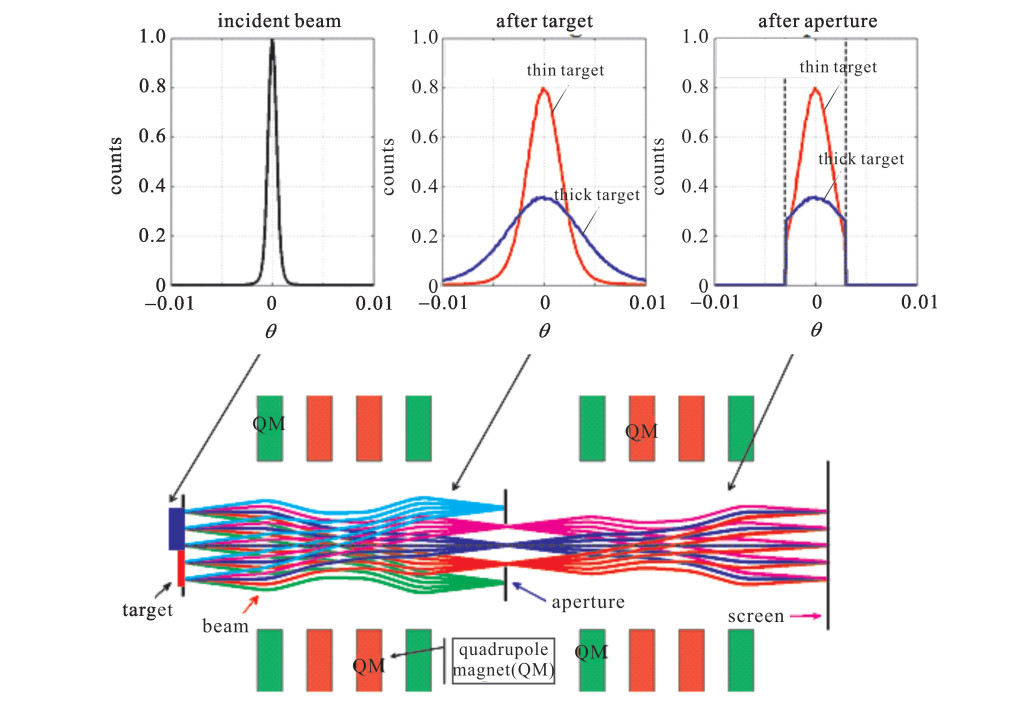
 下载:
下载:


